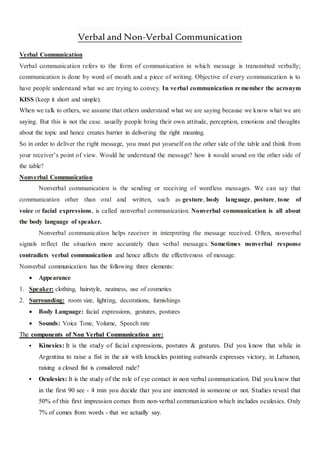
Verbal and non verbal communication
- 1. Verbal and Non-Verbal Communication Verbal Communication Verbal communication refers to the form of communication in which message is transmitted verbally; communication is done by word of mouth and a piece of writing. Objective of every communication is to have people understand what we are trying to convey. In verbal communication remember the acronym KISS (keep it short and simple). When we talk to others, we assume that others understand what we are saying because we know what we are saying. But this is not the case. usually people bring their own attitude, perception, emotions and thoughts about the topic and hence creates barrier in delivering the right meaning. So in order to deliver the right message, you must put yourself on the other side of the table and think from your receiver’s point of view. Would he understand the message? how it would sound on the other side of the table? Nonverbal Communication Nonverbal communication is the sending or receiving of wordless messages. We can say that communication other than oral and written, such as gesture, body language, posture, tone of voice or facial expressions, is called nonverbal communication. Nonverbal communication is all about the body language of speaker. Nonverbal communication helps receiver in interpreting the message received. Often, nonverbal signals reflect the situation more accurately than verbal messages. Sometimes nonverbal response contradicts verbal communication and hence affects the effectiveness of message. Nonverbal communication has the following three elements: Appearance 1. Speaker: clothing, hairstyle, neatness, use of cosmetics 2. Surrounding: room size, lighting, decorations, furnishings Body Language: facial expressions, gestures, postures Sounds: Voice Tone, Volume, Speech rate The components of Non Verbal Communication are: Kinesics: It is the study of facial expressions, postures & gestures. Did you know that while in Argentina to raise a fist in the air with knuckles pointing outwards expresses victory, in Lebanon, raising a closed fist is considered rude? Oculesics: It is the study of the role of eye contact in non verbal communication. Did you know that in the first 90 sec - 4 min you decide that you are interested in someone or not. Studies reveal that 50% of this first impression comes from non-verbal communication which includes oculesics. Only 7% of comes from words - that we actually say.
- 2. Haptics: It is the study of touching. Did you know that acceptable level of touching vary from one culture to another? In Thailand, touching someone's head may be considered as rude. Proxemics: It is the study of measurable distance between people as they interact. Did you know that the amount of personal space when having an informal conversation should vary between 18 inches - 4 feet while, the personal distance needed when speaking to a crowd of people should be around 10-12 feet? Chronemics: It is the study of use of time in non verbal communication. Have you ever observed that while AN employee will not worry about running a few minutes late to meet a colleague, a manager who has a meeting with the CEO, a late arrival will be considered as a nonverbal cue that he / she does not give adequate respect to his superior? Paralinguistics: It is the study of variations in pitch, speed, volume, and pauses to convey meaning. Interestingly, when the speaker is making a presentation and is looking for a response, he will pause. However, when no response is desired, he will talk faster with minimal pause. Physical Appearance: Your physical appearance always contributes towards how people perceive you. Neatly combed hair, ironed clothes and a lively smile will always carry more weight than words. Body Language 1. Eye Contact: Always maintain eye contact with your audience. However, a person must ensure that he / she should not fix his gaze at one person for more than 5 seconds. Too much fluttering of eyes could indicate lack of confidence. Staring at a person could be daunting and hence is not such a good idea. 2. Hand Shake: While shaking hands especially in a professional environment, the hand shake should be firm and not loose. An iron handshake [very strong handshake] can indicate that a person is trying to dominate. 3. Crossing your Arms: Crossing your arms could imply that a person is not open to new ideas / opinion especially in case of giving a presentation. However, in a one-on-one interview if the interviewer has his / her arms crossed, the candidate could do the same. 4. Sitting Posture: Leaning on a chair is not a good idea. One must sit upright though in a relaxed position. Sitting back in your chair implies lack of interest or rejection. 5. Gesture: Gesture refers to a type of non verbal communication which uses a part of the body with or without verbal communication. Gestures include facial expressions, nods [which is a sign of approval in most cultures], head bobbling / shaking. 6. Facial Expression: The face is a best reflection of what a person feels. More often than not it is easy to recognize if a person is happy, sad, anxious, irritated, or excited. It is very important that in a professional scenario a person must control his / her facial expressions. For e.g. If a presenter gets a
- 3. feel that his presentation is not going on very well, he / she should not show the sign of losing of hope and instead try for a greater involvement from the participants.
